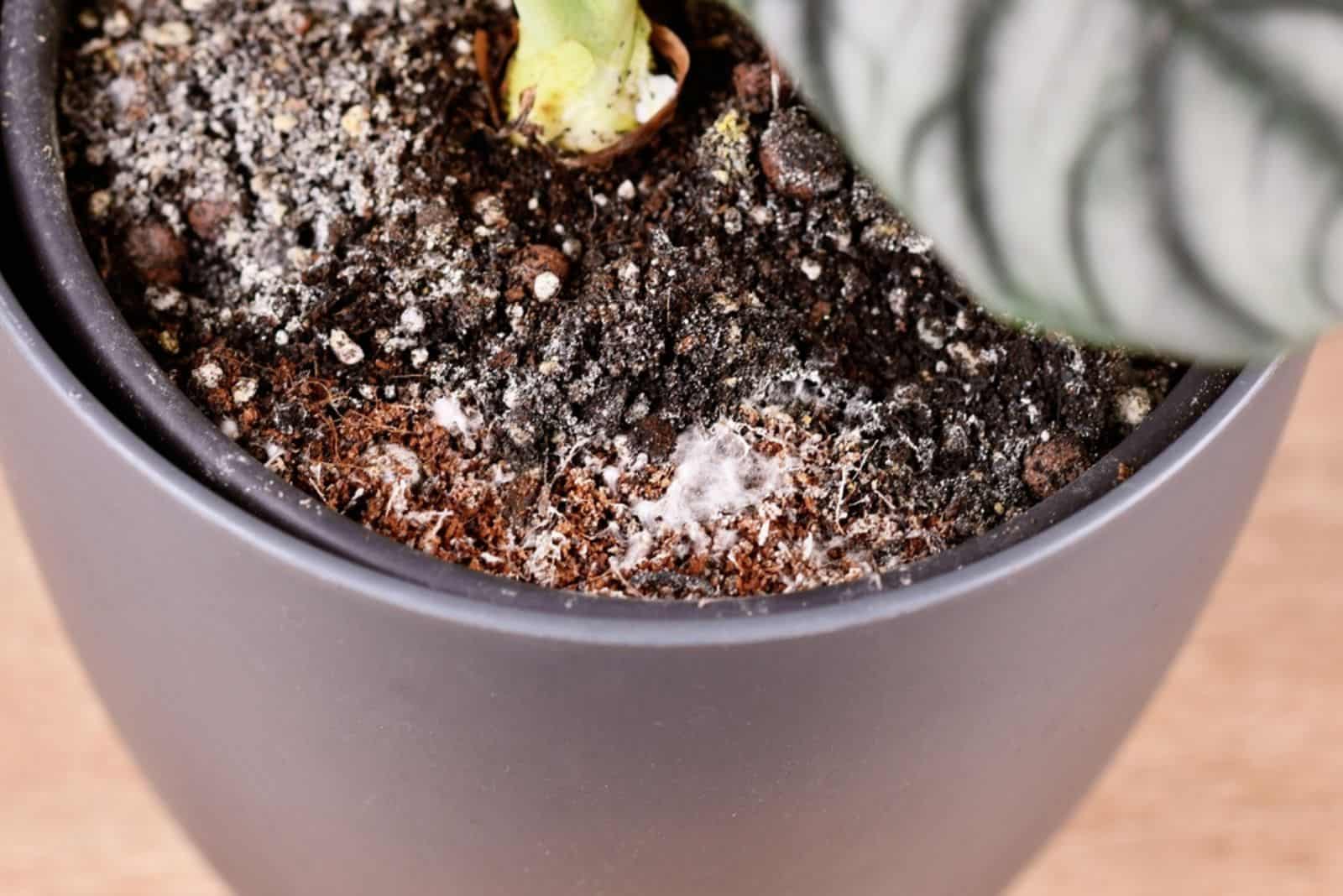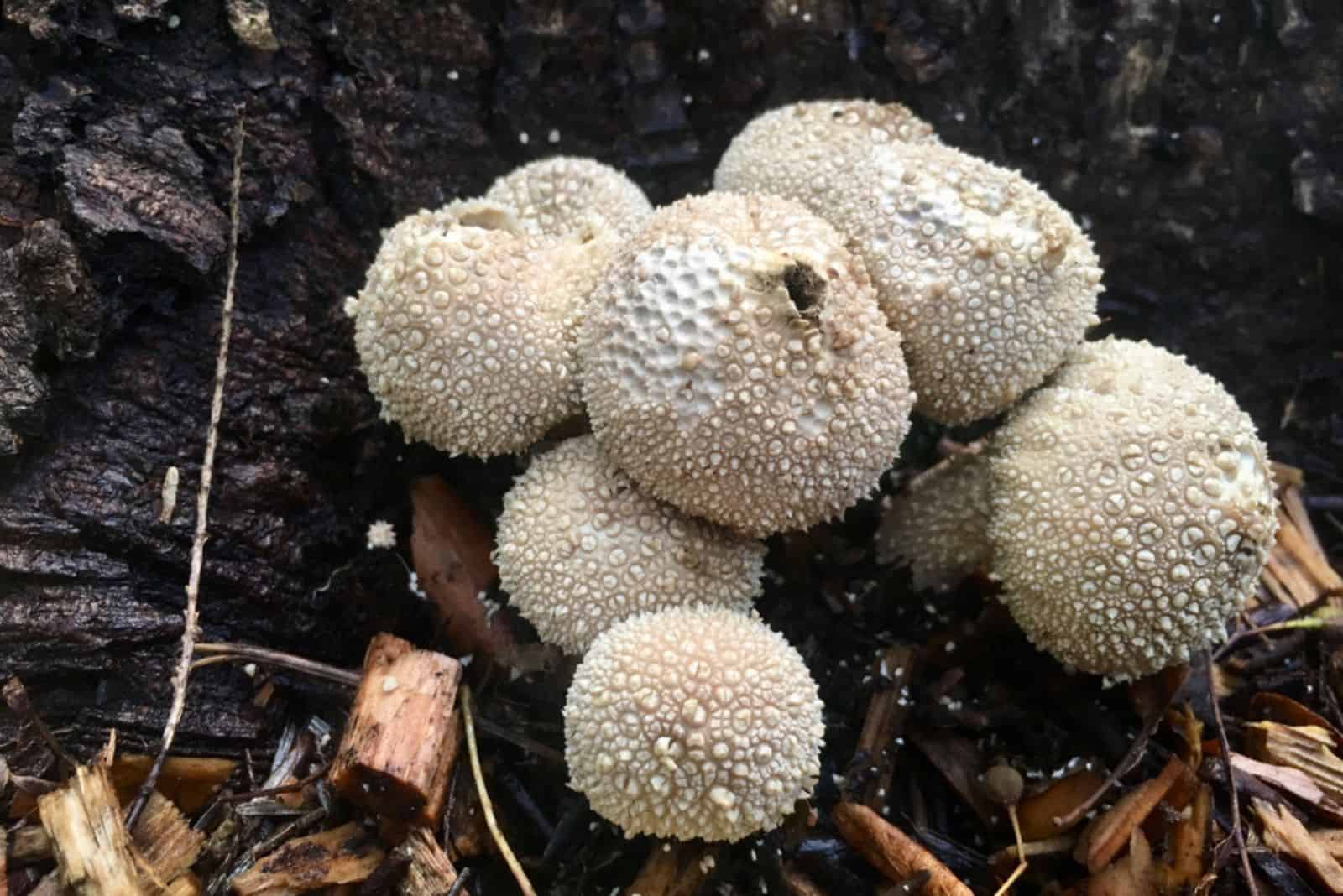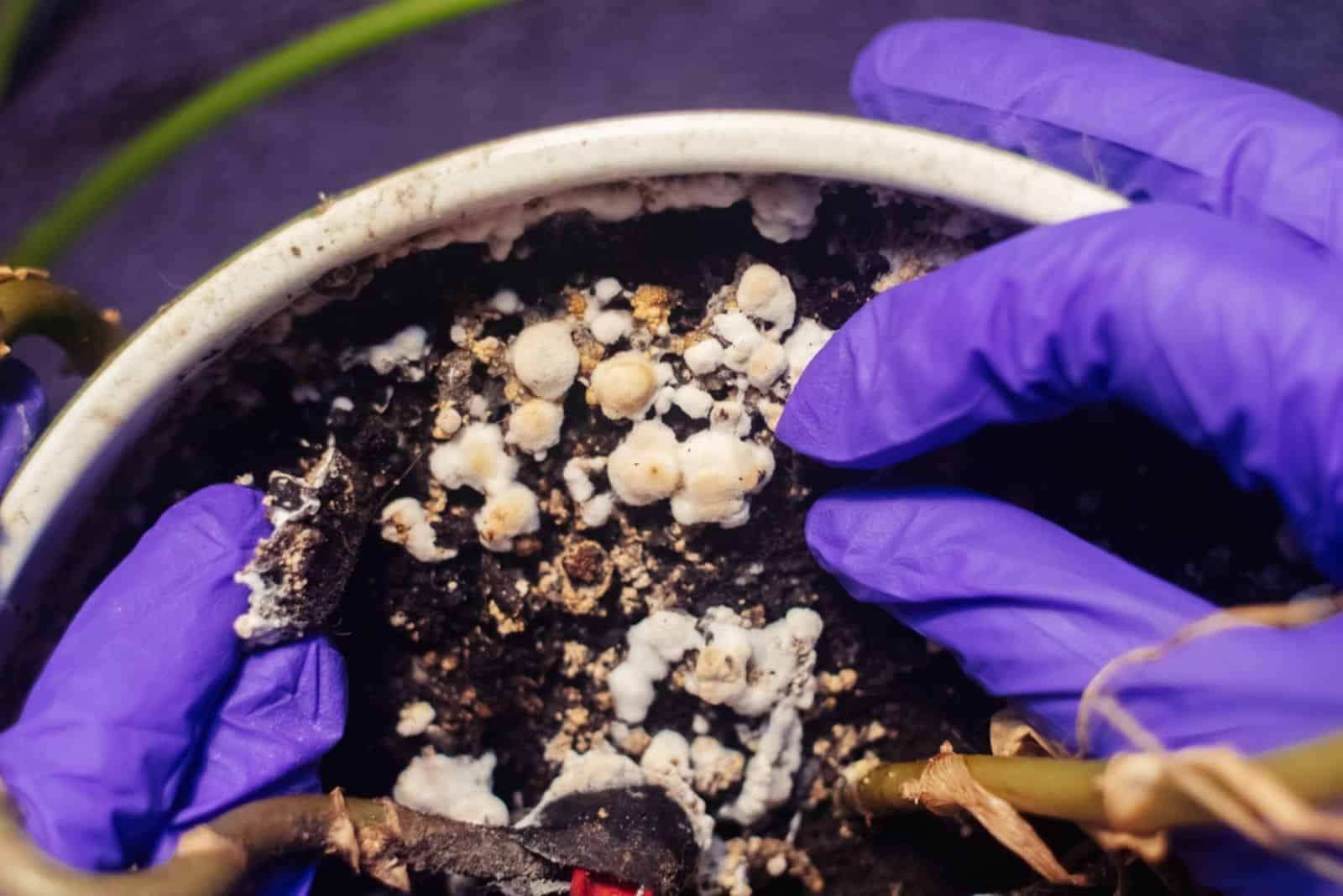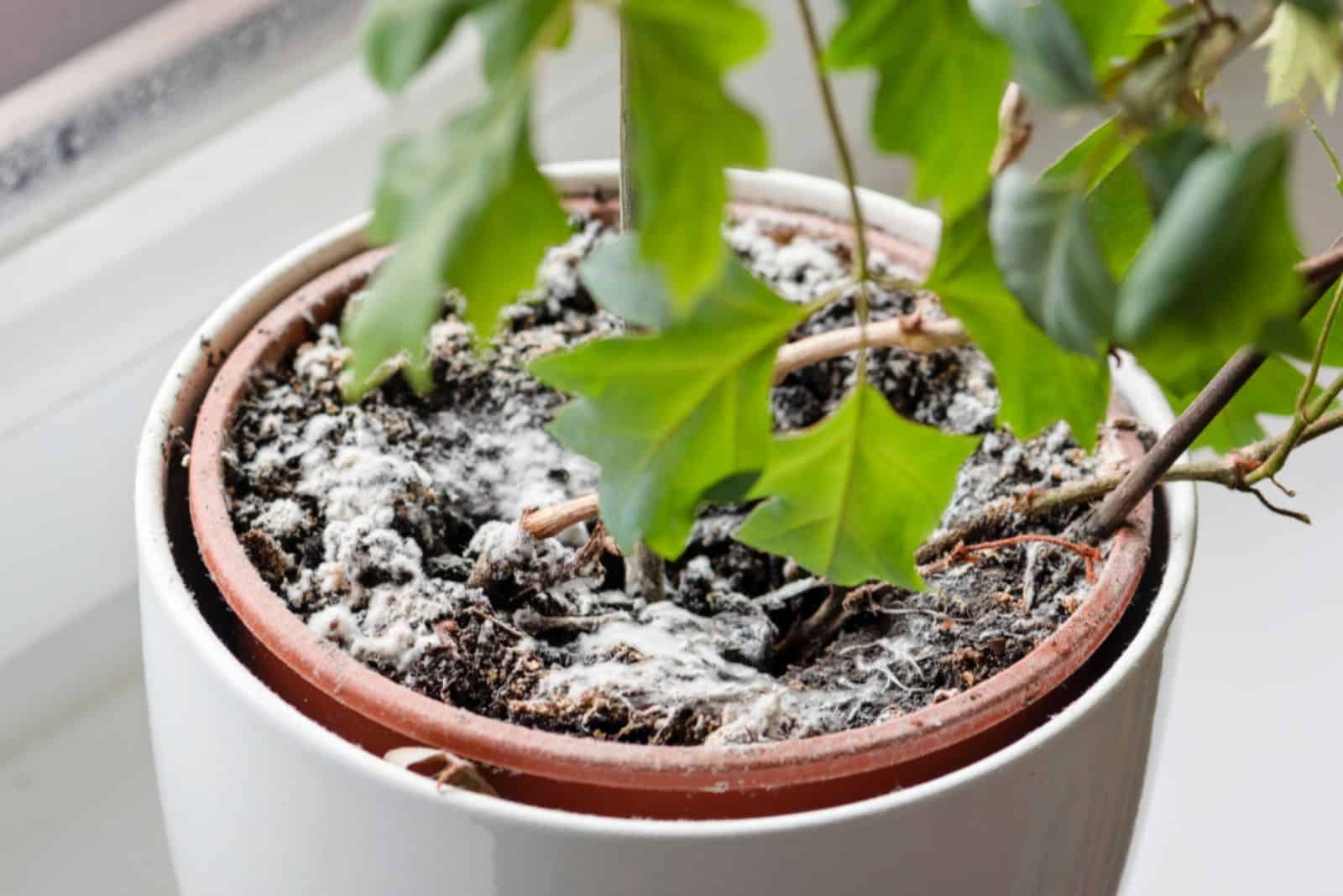When you spot white fungus balls in soil, you might often think that there is something wrong with your plant. However, not all fungi are harmful to plants. Some fungi are in a symbiotic relationship with plants and help them grow and absorb nutrients.
The most important thing is identifying what type of fungi you are dealing with.
In some cases, perlite gets mistaken for a fungus ball, as it is also a small, white, and round soil additive that is often added to improve drainage of the potting mix. So, how can you know when you should be worried?
To get an answer to that question, keep reading to find out what those little white puffballs in your plants’ soil are.
White Fungus Balls In Soil
If you have been growing houseplants for a long time, you have probably already encountered tiny white balls appearing on the surface of the soil. My first thought was that they were insect eggs, but I’ve noticed that they contain fuzz or hairs around their spheres, which is not characteristic of insect eggs.
So, if those white balls are fuzzy, then you are dealing with fungal colonies. In most cases, if you leave them to grow then you are probably going to end up with mushrooms.
However, you should learn to tell what type of fungi you are dealing with in order to get rid of it.
Let’s look closer.
How To Identify Them
White fungus balls come in different shapes and sizes. Some fungal balls are completely harmless, while others might cause some damage to your plant’s roots. This is why it is important to learn to tell them apart.
There are three types of tiny white balls: saprophytic fungus, puffball fungus, and tiny white eggs.
Saprophytic Fungus
Saprophytic fungi are not harmful. In fact, they are much more beneficial. Their appearance is often a sign that the growing conditions for your indoor plants are not ideal, but they won’t cause any harm to your plant.
These fungi are small, fuzzy, and white. Those tiny, white, fuzzy balls are just hyphae of a fungus, and the fuzzy areas around the spheres are their roots.
They can break down organic matter into nutrients and minerals. Once they colonize, they can make the potting soil hydrophobic. This greatly affects the plant’s well-being; however, you can remove them before they colonize.
You will be able to easily spot them as they look like fuzzy white mold on the topsoil.
Puffball Fungus
If those white balls look like golf balls, then you are probably dealing with Puffball fungus, otherwise known as the Stinkhorn fungus. They are caused by a specific fungal type called Phallaceae. These usually hide beneath the surface of the soil until they develop a thread structure that enables them to spread and move from the fruiting bodies.
If left untreated, they will start growing around your plant. While they cannot harm your plant directly, they leave an unpleasant odor that attracts pests that could possibly harm your plant.
I’m sure that you’ll want to get rid of them due to the smell in the first place — I mean, they aren’t called Stinkhorns for no reason!
White Egg Clusters
This is the part where it gets tricky — if you notice that there are a lot of small, white balls on your garden soil, don’t just assume that you are dealing with a harmless fungus. Fungus gnats, also known as plant flies, lay eggs in the soil.
Female flies can lay up to several hundred eggs, which turn into larvae that feed on the plant’s roots. This infestation can easily spread to other plants, though you can easily get rid of plant flies.
In addition, if you notice numerous white eggs on your garden soil, then you have probably used undecomposed lawn clippings as mulch. This is simply small, harmless slime mold and not fungal colonies.
While they are not particularly harmful to plants, you’ll still want to keep the fungal growth away from fragile seedlings and young plants. The grass clippings’ natural decomposition is carried out by slime mold. It will grow higher organically in order to generate more fruiting bodies.
Where Do They Come From?
There are various reasons you might spot white fungus balls in your plant’s environment. These micro-organisms are primarily attracted to decaying organic matter. Mushrooms are supposedly a sign of healthy soil, as you may have already heard. This is due to the fact that fresh soil rich in organic matter can serve as a wholesome, productive environment for growing a variety of crops.
Other growing conditions, such as high humidity, warm temperatures, and low light, create a perfect environment for fungi. You might also notice them in the garden after windy weather because this is how their spores are spread.
Once they have settled in, the fungus will produce mycelium, which are thin structures that spread beneath the soil surface. If they are left untreated, they can stay there for a long period of time.
However, they need organic matter to survive. If you are dealing with fungus in potted plants, you can simply let it die out because the nutrients will eventually be spent.
Are White Fungus Balls Toxic To Pets?
If you let these fungus balls grow into mushrooms, then you will have to keep your dogs and cats as far away from them as possible. This is because they are attracted to the fishy smell of fungi in the soil, and most of the mushrooms that are safe for humans are actually harmful to pets.
If ingested, your dog or cat would probably end up vomiting, which is often accompanied by diarrhea, dehydration, and stomach pain.
If your pet has eaten some mushrooms in the yard, you should immediately go to the vet with a picture of the mushrooms, or take some with you so that the vet can determine what type of fungi poisoning they are dealing with.
How To Get Rid Of White Fungus Balls In Soil
If you want to protect your plant, the best thing you can do is get rid of these tiny white balls. There are several methods you can use to get rid of these annoyances. Some of them are organic options, while the others include applying fungicides.
Let’s take a closer look.
1. Dry Out The Soil
We have already mentioned that these fungi thrive in warm and moist environments. I would recommend you provide your plants with better drainage if they often get overwatered. Overwatering frequently results in fungal infections.
Letting the soil dry out is the easiest method you can use to remove white fungus balls from the soil. However, one of the most important steps of plant care is watering. Therefore, you should also ensure that you give your plants just enough water to grow and thrive.
2. Repotting
Getting rid of soil that has been contaminated with all sorts of fungi and bacteria is also a great solution. You will have to spend some time and energy on repotting, but it is quite effective since your plant will now be fungus-free!
Sure, you will have to spend some money on fresh soil, but it is totally worth it. You can also use a new and sterile pot.
3. Remove The Balls Individually
All you have to do is put on some rubber gloves and start picking off the tiny white fluff balls. It is simple to pick off balls that are on the ground; however, not every ball will be on the surface. You’ll need to use a rake to get a closer look.
The soil’s uppermost layers should be removed with caution. Take care not to harm the plant’s roots as you continue to remove any balls that surface.
Don’t simply throw them outside or in the compst bin — you will have to properly dispose of them in order to prevent them spreading.
4. Apply Fungicide
Applying fungicide is probably the most effective method, though many gardeners tend to use organic options because they believe it is much safer. Nonetheless, I didn’t have any issues when applying fungicides.
You can use liquid copper fungicides for treating white fungus balls in soil. Be careful when handling these types of chemicals, and always make sure to follow the instructions displayed on the packaging.
However, you can also use neem oil as a natural fungicide, but more on that in the section below.
Read also: Copper Fungicide Vs Neem Oil: What’s The Better Option?
5. Organic Methods For Treating Fungus
You can also get rid of fungus by using natural products like neem oil, vinegar, or baking soda.
Neem oil is an effective fungicide and pesticide commonly used for treating different plant issues. For instance, this method can help you get rid of the fungus in mulch.
Two tablespoons of neem oil are often mixed with a gallon of water and then applied to the soil. You can also add some dishwasher soap for more effective results. This water is poured on the affected soil every week.
Similarly, baking soda and soap can be mixed with a gallon of water and then applied to the affected area. To help stop it from coming back, you can also lightly sprinkle cinnamon over the soil’s surface. The flavor and fragrance of cinnamon are derived from cinnamaldehyde, a natural fungicide that aids in preventing the growth of mold.
When it comes to vinegar, it should only be used for acid-loving plants. Since it is non-selective, anything it comes into contact with will be harmed or even killed due to its high acid content.
You can mix one gallon of water with one cup of vinegar and use it to irrigate your plants if you’re looking to get rid of white fungus balls in the soil. However, to prevent any potential harm to these lovely shrubs, stay as far away from the leaves and stems as you can.
Frequently Asked Questions
What is the white stuff in my soil?
The white stuff in your soil is probably fungus that has started growing due to its high organic content and warm and humid environment. White fungus balls can be different shapes and sizes, depending on the type of fungi.
In most cases, they are not harmful. In fact, if you keep them on the soil, they will start growing into small yellow mushrooms. However, it is advisable to get rid of it.
The most dangerous thing would be white eggs, which are actually insect eggs that will develop into larvae and destroy your plant’s roots. Get a magnifying glass and carefully examine the white stuff in your soil.
What causes white fungus balls in soil?
They are attracted to nutrient-rich soil and decaying organic matter. If the growing conditions are quite humid and warm, your plant will most likely end up with fungus in the soil, especially if you tend to overwater it.
To Sum Up
Now you know that white fungus balls in soil aren’t extremely harmful, so stop worrying!
Just be careful not to leave them on the soil for too long, especially if you are dealing with white eggs — in this scenario, I would recommend you get completely new soil and a new pot for your plant. The same goes for root rot.
Getting rid of white fungus balls from the soil is quite easy. You can try letting the soil dry out first; if that doesn’t work, then use the next method. Your last option should be applying fungicide.
If they have already grown many colonies, apply copper fungicide carefully. Always follow the instructions displayed on the packaging and stay safe!
That’s all, folks. I hope this article was helpful.
Until next time!




